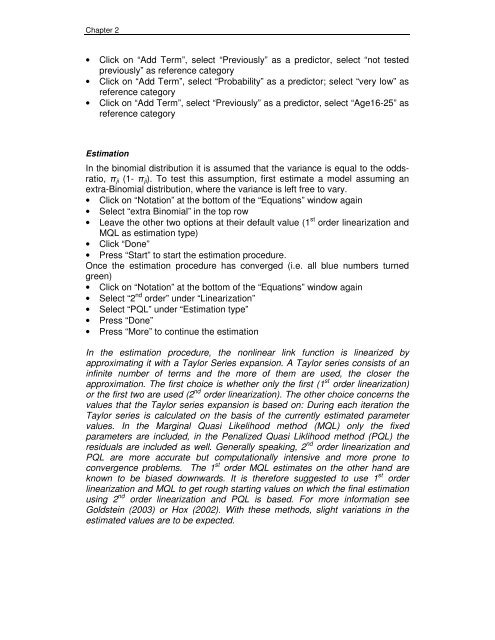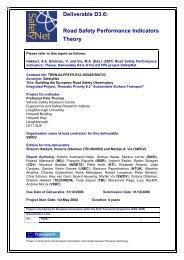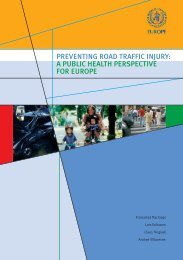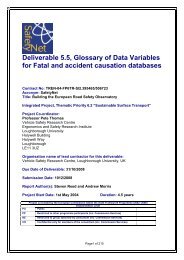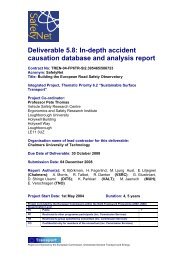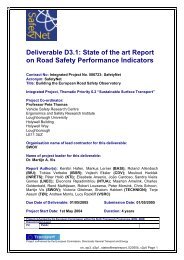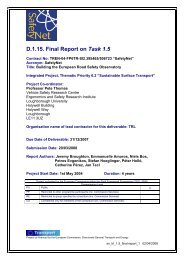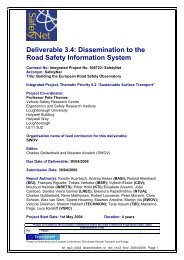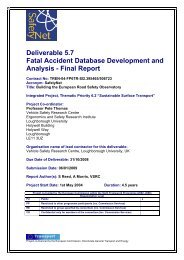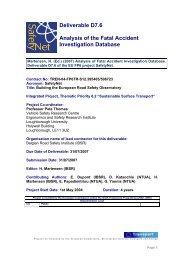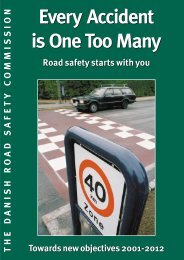Multilevel modelling and time series analysis in ... - ERSO - Swov
Multilevel modelling and time series analysis in ... - ERSO - Swov
Multilevel modelling and time series analysis in ... - ERSO - Swov
Create successful ePaper yourself
Turn your PDF publications into a flip-book with our unique Google optimized e-Paper software.
Chapter 2• Click on “Add Term”, select “Previously” as a predictor, select “not testedpreviously” as reference category• Click on “Add Term”, select “Probability” as a predictor; select “very low” asreference category• Click on “Add Term”, select “Previously” as a predictor, select “Age16-25” asreference categoryEstimationIn the b<strong>in</strong>omial distribution it is assumed that the variance is equal to the oddsratio,π ji (1- π ji ). To test this assumption, first estimate a model assum<strong>in</strong>g anextra-B<strong>in</strong>omial distribution, where the variance is left free to vary.• Click on “Notation” at the bottom of the “Equations” w<strong>in</strong>dow aga<strong>in</strong>• Select “extra B<strong>in</strong>omial” <strong>in</strong> the top row• Leave the other two options at their default value (1 st order l<strong>in</strong>earization <strong>and</strong>MQL as estimation type)• Click “Done”• Press “Start” to start the estimation procedure.Once the estimation procedure has converged (i.e. all blue numbers turnedgreen)• Click on “Notation” at the bottom of the “Equations” w<strong>in</strong>dow aga<strong>in</strong>• Select “2 nd order” under “L<strong>in</strong>earization”• Select “PQL” under “Estimation type”• Press “Done”• Press “More” to cont<strong>in</strong>ue the estimationIn the estimation procedure, the nonl<strong>in</strong>ear l<strong>in</strong>k function is l<strong>in</strong>earized byapproximat<strong>in</strong>g it with a Taylor Series expansion. A Taylor <strong>series</strong> consists of an<strong>in</strong>f<strong>in</strong>ite number of terms <strong>and</strong> the more of them are used, the closer theapproximation. The first choice is whether only the first (1 st order l<strong>in</strong>earization)or the first two are used (2 nd order l<strong>in</strong>earization). The other choice concerns thevalues that the Taylor <strong>series</strong> expansion is based on: Dur<strong>in</strong>g each iteration theTaylor <strong>series</strong> is calculated on the basis of the currently estimated parametervalues. In the Marg<strong>in</strong>al Quasi Likelihood method (MQL) only the fixedparameters are <strong>in</strong>cluded, <strong>in</strong> the Penalized Quasi Liklihood method (PQL) theresiduals are <strong>in</strong>cluded as well. Generally speak<strong>in</strong>g, 2 nd order l<strong>in</strong>earization <strong>and</strong>PQL are more accurate but computationally <strong>in</strong>tensive <strong>and</strong> more prone toconvergence problems. The 1 st order MQL estimates on the other h<strong>and</strong> areknown to be biased downwards. It is therefore suggested to use 1 st orderl<strong>in</strong>earization <strong>and</strong> MQL to get rough start<strong>in</strong>g values on which the f<strong>in</strong>al estimationus<strong>in</strong>g 2 nd order l<strong>in</strong>earization <strong>and</strong> PQL is based. For more <strong>in</strong>formation seeGoldste<strong>in</strong> (2003) or Hox (2002). With these methods, slight variations <strong>in</strong> theestimated values are to be expected.


